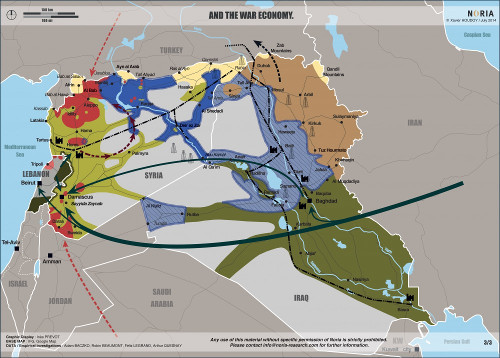The meaning of the various dynamics at work in today’s Iraq and Syria lies in their interactions. This poses a twofold challenge to the cartographers: on the one hand, to represent complex processes; on the other hand, to consider the perceptions and interpretations of the readers during the conceptualisation stage. Thus, not only for the sake of clarity, but also as a matter of cautiousness regarding the use that could be made of this work, we have chosen to use a triptych, with one title and one general legend for our three maps, which we consider impossible to apprehend separately.
While maps are the most adequate tool for the representation of various situations and dynamics, such as strategies for the acquisition of territorial control, their limits also appear quite easily. How can we capture the very pragmatic and punctual nature of certain alliances that imply fluctuating intensity and scope in terms of time and space? How should we differentiate between their symbolic and political importance and their territorial weight? Is it even conceivable to show a “Shia axis” when, despite its undeniable relevance in some areas, it remains a cumbersome cliché, which largely denies fundamental nuances? Last but not least, how best to show the weakening of a State other than in terms of territorial losses?
As already pointed out by Bénédicte Tratnjek regarding an other piece on Syria, working on ongoing conflicts, where the situation evolves on a daily basis, means working without anything like perfectly consistent and comprehensive data, even though those were collected and cross-checked, as is the case here, by researchers on the field. In that sense, these maps aim at allowing local, national, and regional dynamics to appear without exaggerating the differences between the various groups, neither to homogenize them.
These maps are based on data gathered by Adam Baczko, Robin Beaumont, Felix Legrand and Arthur Quesnay in Syria and Iraq during field trips of various length spanning from Summer 2013 to June 2014. Read their article, Sectarian Strategies, National Settings and the War Economy in Syria and Iraq
Designed with the support of the European Research Council-funded program WAFAW.

